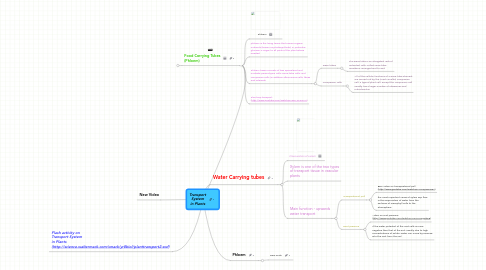
1. Food Carrying Tubes (Phloem)
1.1. Phloem
1.2. phloem is the living tissue that carries organic nutrients (known as photosynthate), in particular, glucose, a sugar, to all parts of the plant where needed
1.3. Phloem tissue consists of less specialized and nucleate parenchyma cells, sieve-tube cells, and companion cells (in addition albuminous cells, fibres and sclereids
1.3.1. Sieve tubes
1.3.1.1. The sieve tube is an elongated rank of individual cells, called sieve-tube members, arranged end to end
1.3.2. Companion cells
1.3.2.1. All of the cellular functions of a sieve-tube element are carried out by the (much smaller) companion cell, a typical plant cell, except the companion cell usually has a larger number of ribosomes and mitochondria
1.4. Plant sap transport (http://www.youtube.com/watch?v=zznV9TIF9AU)
2. Flash activity on Transport System in Plants (http://science.waltermack.com/smack/yr8biol/planttransport2.swf)
3. New Video
4. Water Carrying tubes
4.1. Cross section of a stem
4.2. Xylem is one of the two types of transport tissue in vascular plants
4.3. Main function - upwards water transport
4.3.1. Transpirational pull
4.3.1.1. BBC video on transpirational pull (http://www.youtube.com/watch?v=J1PqUB7Tu3Y)
4.3.1.2. the most important cause of xylem sap flow is the evaporation of water from the surfaces of mesophyll cells to the atmosphere
4.3.2. Root pressure
4.3.2.1. Video on root pressure (http://www.youtube.com/watch?v=nFL2YNgNb68)
4.3.2.2. If the water potential of the root cells is more negative than that of the soil, usually due to high concentrations of solute, water can move by osmosis into the root from the soil
